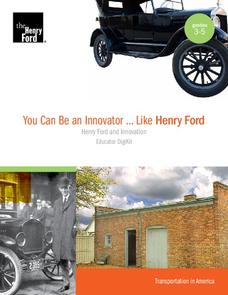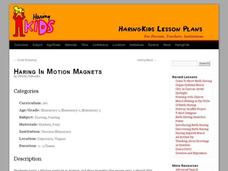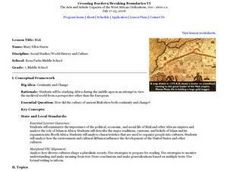Jumpstarting Journeys
Vowel Digraph Activities for au and aw
It can be awfully hard teaching young children how to read, but this phonics resource will make the job a little easier. Focusing on the au and aw vowel digraphs, this collection of engaging activities teaches beginning readers how to...
Civil War Trust
Gettysburg Address
The Gettysburg Address may have been four score and seven years ago, but its message is still as relevant today. Young historians explore the context of the famous speech, as well as its central theme and argument, before discussing the...
Media Smarts
The Broadcast Project
As part of a unit on media studies, kids are asked to chart their viewing habits, observe the advertising that sponsors their favorite shows, and then to imagine what they would broadcast if given a block of airtime.
Alabama Department of Archives and History
Alabama BEFORE the American Revolution
Did you know that prior to the American Revolution, Alabama was a part of the British empire and called New West Florida? Class members research the economic, political, and social realities of this territory and compare them to those of...
C-SPAN
The Electoral College and the Constitution
What is the purpose of the Electoral College? Is it antiquated, or does it have a place in today's political climate? High schoolers view a series of video clips as they analyze the parts of the United States Constitution that address...
Turabian Teacher Collaborative
Parts of Argument II: Article Critique
Break down the parts of argumentative writing with a critical thinking activity. High schoolers read an article of your (or their choice), and use a graphic organizer to delineate the ways the author structures his or her arguments.
Henry Ford Museum
You Can Be an Innovator ... Like Henry Ford
Why did Henry Ford want to invent a car for the masses? Why did Henry Ford locate his factory in Detroit? Why did Henry Ford encourage the idea of a 5-day work week? Young innovators find the answers to these and other question in a unit...
Ohio Literacy Resource Center
Compare & Contrast Essay
Comparing two texts can build a greater understanding of the texts and themes of the works. Take some time to follow the steps here to guide your pupils through the process of composing compare-and-contrast essays.
Curated OER
Seed Swapping
Here is a fabulous, cross-curicular lesson on seeds. Elements of science, writing, math, agricultural practices, and art are all brought into this incredibly thorough plan. Additionally, a fun whole-class game is presented, and there is...
Pardee Home Museum
Geography of Alaska
A unit on the 49th state covers a variety of topics from the geography of Alaska to Native American myths. Academics work to analyze information found in primary source materials including old newspaper articles and artifacts. Young...
Newspaper Association of America
Cereal Bowl Science and Other Investigations with the Newspaper
What do cereal, fog, and space shuttles have to do with newspapers? A collection of science investigations encourage critical thinking using connections to the various parts of the newspaper. Activities range from building origami seed...
Curated OER
Grade A: The Market for a Yale Woman's Eggs by Jessica Cohen
What would it be like to sell your eggs to a couple who can't have children on their own? Could you even imagine it? As most of us have never been in this position, this descriptive essay is really quite interesting. The reading itself...
Pearson
Articles: Indefinite
When do you use a or an before a noun? What about the? Learn about indefinite and definite articles with a brief grammar presentation, which focuses on using context clues to determine proper article usage.
K5 Learning
Space Based Astronomy
How much astronomy can you study with the naked eye? Learn more about the ways scientists explore the galaxy with a short reading passage and set of short-answer questions.
Channel Islands Film
Once Upon a Time (Sa Hi Pa Ca): Lesson Plan 3
What was the most significant tool used by the Chumash? How did the environment make the tool possible? What group behaviors allowed the Chumash be be successful for thousands of years? After watching West of the West's documentary Once...
Open Oregon Educational Resources
Conventions 101: A Functional Approach to Teaching (and Assessing!) Grammar and Punctuation
Let's eat kids. Let's eat, kids. Commas make a difference! Conventions 101: A Functional Approach to Teaching (and Assessing!) Grammar and Punctuation explains ways to teach the importance and use of conventions. Learners take part in...
Curated OER
I Am Special, You Are Special Too #2
After being read a story, the students attempt to identify one individual difference, and one thing about themselves that is similar to other students in the class and one thing that makes them special. For the art lesson plan, students...
Curated OER
Found Poetry with Primary Sources: The Great Depression
Pupils read a sample found poem and create one together as a class. In this Great Depression lesson, students select a topic, such as miners, and read primary source documents related to the topic. Pupils select one narrative as the...
Curated OER
The Role of the Museum
Young scholars identify the role of the museum as a cultural resource in the community. They use primary and secondary sources to evaluate institutional, and media influences on people and society in both historical and contemporary...
Curated OER
Haring In Motion Magnets
Students research visual arts by creating an art project for their homes. In this art analysis lesson, students identify the work of Keith Haring by researching the Internet and examining images. Students utilize tempera paints, poster...
Curated OER
A House Divided: Slavery in the United States
Students explore the history of the United States and slavery. In this slavery lesson plan, students view primary sources, complete journal writing, view videos, and answer short answer questions.
Curated OER
Slavery in America at the Time of the Civil War: Sources
Students discover how to use primary and secondary sources in research. In this Civil War lesson, students conduct research on slavery as they distinguish between primary and secondary sources regarding the same events.
Curated OER
Mali
Seventh graders begin the lesson by reading primary sources about the country of Mali. Using maps drawn in the past, they discuss what they can gather about the country from the map and how it has changed over time. They use a graphic...
Curated OER
Do We See What We Know?
Eighth graders compare two visual works of art about John Brown. They read a text or listen to an interview, and identify information about him. They debate their opinions using evidence in written and visual texts. They research other...
Other popular searches
- Art Lessons Primary Penguins
- Edible Art Lessons Primary
- Art Lessons Primary Easter
- 3d Art Lessons Primary
- Art Lessons Primary Fruit
- Winter Art Lessons Primary
- Maori Art Lessons Primary
- Visual Art Lessons Primary
- Art Lessons Primary Tiger
- Art Lessons Primary Water
- Art Lessons Primary Victoria
- Art Lessons Primary Art

























